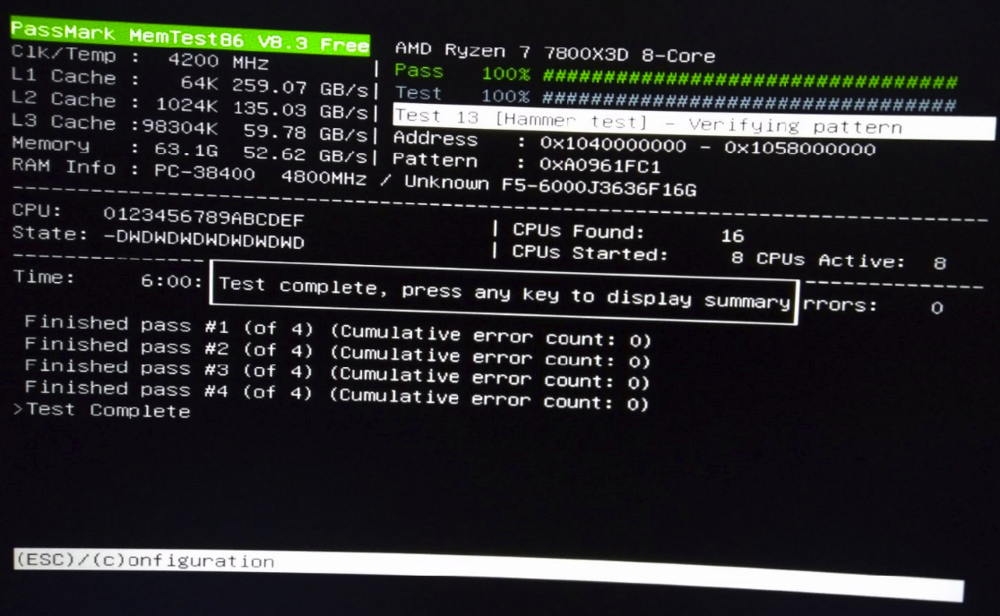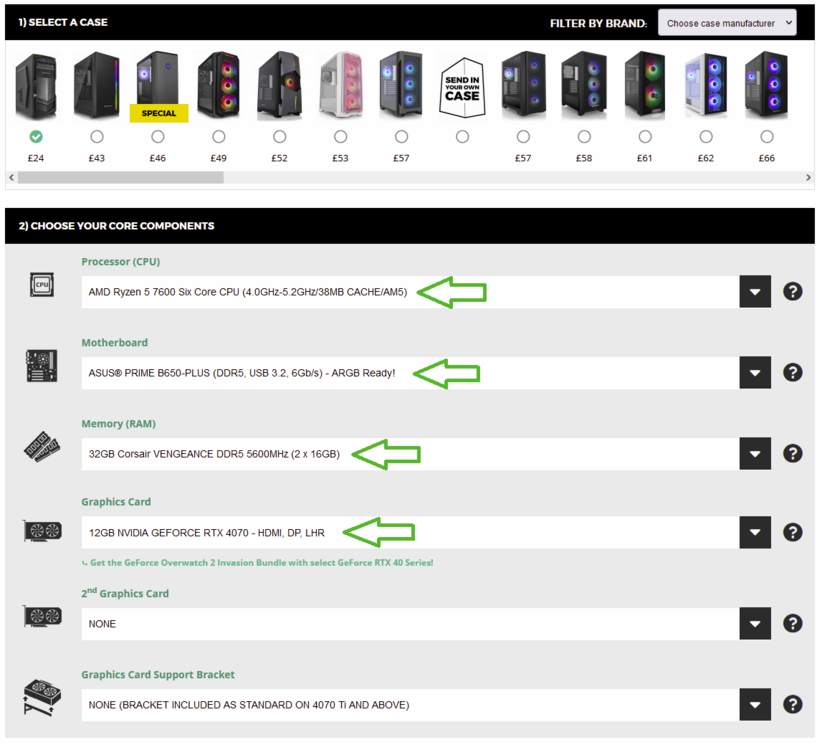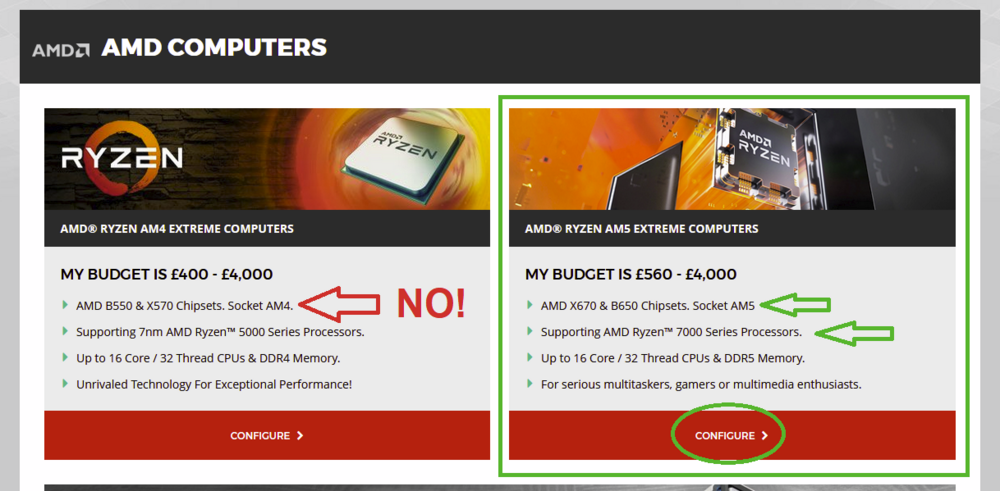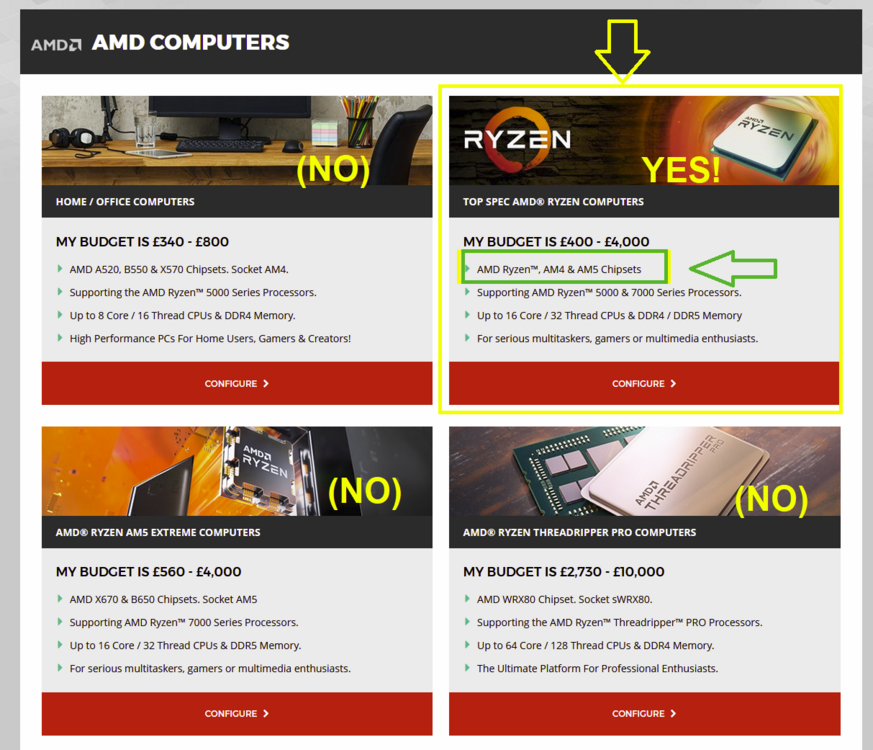

kksnowbear
Members-
Posts
880 -
Joined
-
Last visited
Content Type
Profiles
Forums
Events
Everything posted by kksnowbear
-
Yes, I am aware of all that...yet the results I've shown above are conclusive proof that the official specs are not absolute. And 4800 is a damn sight beyond the 'guaranteed 3600'. A full 33% more, to be exact, which is definitely significant (and in fact just as close to 6000 as it is far from the 'guaranteed 3600', so hardly "significantly closer'). In case you hadn't noticed, that's a Zen4 CPU in the picture I posted. Looks like "AMD Zen4, 4 sticks = outperforming factory specs" to me. There's also no proof at all that any system that runs 3600 will have issues with stuttering. I'm sure, if I were to try, I could find someone who runs DDR5 at 3600 and has no issues with stutters. What makes me so sure? Well, among other things, at least according to AMD, that's the max speed you can get with 4 modules - but I'd bet there are at least a few people running DCS with four modules on an AM5 board without having stutters. If running 4 modules means no more than 3600, and 3600 means stutters...then logically, everyone with 4 modules would have stutters. Somehow I don't really think that's the case.
-
Which is why the person who designed the system should've been aware - and should stand behind it, as I described. Doesn't change anything: Like I said, if I sold it, I'd make it work as I represented or give a refund. You *can* run 4 modules, and it doesn't have to be at 3600: Below is a picture of a build I did earlier this year, running MemTest 8. 64G, all four slots populated (second pic). Running 4800** (not 3600) and if I'd played with it more I am fairly certain I'd get more out of it, I just didn't have time; the client was happy to get better than what AMD says is officially max and was glad to take the system without needing to wait for me to fiddle with it more. ** Yes, I know it's 6000 RAM, but that ain't the point lol...AMD says not more than 3600 with 4 modules - which clearly isn't always true. It simply depends on a number of factors.
-
Naturally, the "technical solutions" I referred to includes hardware choice, albeit that is unfortunately in retrospect at this point. If this was the result of working with a competent professional then they should be willing to either demonstrate it can work, or issue a refund (provided it's within a reasonable time frame and no misuse or damage has occurred).
-
Right...these are among the "technical solutions" I was referring to, of course. Not by any stretch the extent of the methods, either (after even a little legwork, I find it seems likely that several other factors are at work). I didn't see the need to go into detail, TBH, because (to me) there appears a very limited understanding of the subject at hand, and - in my professional assessment - this is not only causing the problem, but is likely to make arriving at a solution exceptionally difficult if not impossible for that poster, unaided. To prove the point, the end result is a conclusion which is almost certainly inaccurate (i.e. two sticks good, four sticks bad). Again, my advice - particularly in that case - work with a competent professional.
-
While I understand everyone's experience is different, I strongly disagree with the conclusion being drawn. For one, if this were true, there probably wouldn't be any four-slot boards - yet there are lots. There also definitely wouldn't be lots and lots of people running four sticks - yet there are. In the time I've built and maintained computers professionally (40 years or so), there have been challenges at times getting four sticks to run - but it's not impossible. There are actual technical reasons it can be problematic, but just as well, there are real technical solutions. As stated above, too little RAM can be a dismal failure where faster RAM is often unremarkable. My advice, work with the right professional.
-
EDIT: OK, so digging deeper...turns out the links are somehow goofy and they don't take you to the RAM that he says he's actually testing. So there's that. But, even when I finally scanned through the video and found where the speeds/latencies are shown, here's what we come up with: 32G 8000 CL36 (9ns) 48G 8000 CL36 (9ns) 64G 7200 CL32 (8.88ns) So these are supposedly what he's actually testing. (Would've been nice had he actually mentioned accurate values for CAS somewhere so one could search the transcript, or linked the actual modules he was testing). Anyhow...given the values he listed in the video, there's an obvious difference...the 64G kit is a slower kit. Even with better latency, it's still not as fast as either of the other two kits. I do realize the state of affairs is such that you're pretty much topped out as far as kits with certain speed/latency...but, if the test is supposed to be apples and oranges (as it should be), then he should be testing kits of the same speed and latency. Otherwise, it's just not a valid conclusion. Laying aside the differences above, let's look at the actual results in the video: I don't think he actually discussed his methodology, but particularly if the numbers he cites are not an aggregated result of (many) multiple runs, they're not terribly accurate. I'm not sure how he conducted his tests, but the differences in those charts could easily be margin of error. He's running tests with a 4090 at 1080p; frame rates are in the 200-300+ range (for obvious reasons). The differences in the game charts are single digits of multi-hundred values - in other words, usually around 2-5%. And while this can actually be measured, no one is ever going to be able to reliably and accurately notice 5 frames out of 300+. Toward the end he finally goes up to 1440 resolution and sees at one point on the order of 16 frames out of ~255, which amounts to ~6%. Again, though it can be measured, no one can reliably and accurately "see" the difference in 247 and 263 FPS. (In fact, as I mentioned earlier, this is fairly easy to prove, but that's another discussion)... Anyhow, I've edited my original reply after looking more closely at the video. It was kind of a waste of time TBH because the conclusion is exactly the same: Forget about some minuscule difference in a value that, although possibly measurable, isn't noticeable in any practical context, and go with what can make a much bigger difference (i.e., having 64G RAM vs 32 for running DCS). As always, my own $0.02
-
Without going into a lot of agonizing detail, I'd do 64 no question (and I actually did, it happens). Mind you that assumes the difference in speed is within a certain range. You don't specify speeds or CAS level (which is important and can 'level the field by itself). Admittedly I haven't tested it, but it does seem there are a lot of (at least anecdotal) experiences reported that the sim will use more than 32G. So I think having more RAM is likely a more noticeable difference 'in game' than if the memory were only slightly faster (which is something you're not even likely to notice, TBH). Generally, unless there's a very big difference in speeds, then I think - assuming the game uses it (which DCS apparently does) - that having twice the RAM is going to be of more benefit overall than something that's slightly faster. Just my $0.02 FWIW
-

Intel i9-13900k or AMD 7950X3D for DCS in VR
kksnowbear replied to Platypus's topic in PC Hardware and Related Software
Lol yeah sorry about that...I realized it later -

Intel i9-13900k or AMD 7950X3D for DCS in VR
kksnowbear replied to Platypus's topic in PC Hardware and Related Software
It's important to note that my comment above isn't specifically related to VR. Although the thread is specifically about VR, I thought a slight diversion would be acceptable in order to address some issues in other comments. That said, I am currently running a X570 board with a 5800X3D, 64G RAM and a 4090 (I play at 5120x1440). Personally, after having built custom gaming machines for many years now, I have been fairly impressed with AMD's last few generations - to the point that I built my own as described, after doing others' AMD builds. This is after a lifetime of using only Intel CPUs in my own machines, for what it's worth. Also, FWIW I had just built myself a new Z390/9900K not long before deciding on AMD, after looking at Intel options and not being very impressed at the time. So...if it were me, I'd build an 7800X3D, I think. (To be perfectly accurate, I've been watching pricing for some time now). Again, though, I'd repeat that even the best of current processors will not actually overcome the biggest limitation - which isn't hardware/core count. -
So...having considered the matter for a little while now, here's what I've come up with: The 4070 (at least right now) is going for ~$600 (and up) retail - before taxes. So it's already over your 'initial base' budget of $500, potentially by ~$150. Also, I have to say I have serious reservations about whether even a 4070 will maintain a 90+ frame rate at 4k in DCS. I'm not even sure you'd get 90FPS most of the time, never mind as a 'fluid' experience. Now, to be accurate, this is based on studying specs, as opposed real-world, first hand experience. I think it would be a great idea for you to seek out others here on the forum who actually have 4070s and run 4k - you'd probably want to title a new thread very specifically to get the appropriate responses. I regret that I cannot speak from that first hand experience. I do know, first hand, that a 3090 at 1440p will do 100+ FPS at altitude...but get on certain maps and down low near densely populated buildings etc...you're looking at ~70-80 FPS (and that's not at max settings, either). And a 4070 isn't as capable as a 3090. So you can see why I have real doubts about the 4070 doing what you expect. Maybe the 4070 price will come down as we approach the holidays - they usually do at least somewhat. So maybe it'll be closer to your budget. Unfortunately that won't change the performance aspect, and I'm afraid you'd want something more capable if you want 90 frames stable and smooth. And of course, that's going to increase cost. You might be looking at closer to the upper end of your range (500-800) rather than the lower end. Maybe finding something used would bring performance at a price you could live with. I don't wish to sound pessimistic, but the last thing I'd want to do is say I think it will work OK when I don't honestly think it will. If I'm being honest I think it's going to require that you go to the higher end of your budget, and/or reduce your expectation for performance - and most likely a bit of both. HTH...best of luck Look at the bright side, maybe I'm just plain wrong about it - like I said, ask around to see who's done it already
-
I am very nearly certain there's no such thing as a $250 GPU that will saturate PCIe 3.0 bandwidth at 16 lanes. Unless/until you approach very high-end GPUs (like 3080 and up) the GPU just doesn't have the horsepower to move more data than PCIe 3.0 x16 can handle. And of course, those aren't $250 cards Even with most very high-end cards, the difference is pretty small, typically around 3% I think (though there are isolated exception cases; certain specific games at very high res, etc,) The real issue would be that, long before you have to worry about saturating the GPU bandwidth on that board, you'll be choking a high-end GPU to death with a (*very*) limited CPU in the 4690 (and this applies even if you went to the fastest CPU that board will run). Just my $0.02 FWIW To the OP: In your particular circumstances, IMHO you should reconsider used hardware. There are reputable sources that offer warranty, etc...it's not all some fleaBay crap-shoot. Of course, it's a matter of personal preference, and this is strictly my opinion - but I've been building custom PCs for several decades now (mostly used hardware) to include some for members right here in this very forum/running DCS, no complaints whatsoever. Just gotta find the right guy
-
@Ghostmaker Any update? FWIW I think I'd hesitate to do business with the shop from the original post if they've not responded by now to the inquiry you indicated sending them over a week ago. Did you hear anything from them? Also curious to see how you make out 'test driving' with Qcumber. Any chance to get there yet?
-
So it would seem maybe your head tracking emitter isn't...well, emitting. A guess would be something is up with the head mounted device. I'm assuming that if trackIR didn't find the camera, tge symptoms would be different. Do you have a meter to check power at the head mounted device maybe? (Broken wire perhaps).
-
-
Before considering a ton of various quotes, let me suggest it would be wise to heed the points made by Qcumber earlier, and take him up on his kind offer: This allows an exceptionally rare opportunity to find out if a system like his (5600X/4070 ) is going to be satisfactory to you, whilst running the same sim, etc that you want. And it doesn't cost a thing (hopefully lol) save some time and petrol. OK, maybe a small gesture for him...bring dinner or whatever @Ghostmaker Anything from the shop that gave you the quote in your original post yet?
-
Yeah I found myself an "early adopter" when SATA SSDs first started to become reasonable c.2008 or so. Bought four 30G OCZ Vertex drives and set up a RAID0 array on a "real" (hardware) controller. Very fast for its time, but after the third drive the speed increase wasn't really linear TBH. Of course then PCIe based SSDs came along (RevoDrive, which iirc had an internal RAID volume) and blew the doors off the 4x SATA array anyhow. And then came NVMe lol...
- 8 replies
-
- 1
-

-
- ssd
- provisioning
-
(and 1 more)
Tagged with:
-
Q2: Part of the drive is reserved from use by the system, and is devoted to extending the life of the SSD by replacing NAND cells from the reserved area as the worn cells are retired. TBH, very few people really need to worry about this, but it can depend on what the drive is used for. The cells 'wear' is based on writes to that cell, and unless you're doing a crap ton of writes, it's not really likely to be a problem - and keep in mind the drive will already have a certain amount of space for this, even if you don't 'overprovision' it. Other than that, it will have zero impact on performance. Only in the sense that the lifetime of the drive is part of 'performance' overall. To echo what Bitmaster said above: The Samsung options for performance aren't really what we might consider "performance", in that they don't really improve reads or writes to/from the drive at all. The 'performance' improvement they refer to is about longevity/lifespan of the drive.
- 8 replies
-
- 2
-

-

-
- ssd
- provisioning
-
(and 1 more)
Tagged with:
-
Yessir, you got it. Enjoy your tea while reading the chipset article I'm gonna run off here for a while anyhow (dinner time in the USA!) Meantime you come up with whatever questions you may have.
-
Take what I've done and see if you can run with it. Read the article about chipsets. It's not long and it's very informative. Ask any questions. As I said, this will require some effort, but it's not insurmountable. Hopefully by tomorrow - when the shop responds - we'll be able to say which is a better deal. Figure out what you can do to get to try out Qcumber's system; that's almost certain to be invaluable information in the midst of all this. Now...Aren't you glad you asked?
-
Finally!! A list of stuff to pick from 1. Case: The original list didn't mention a case, so maybe just use something basic (cheap) for now (you can slip through the choices, though and see if something interests you particularly). 2. Core Components...now we're talking...see if you can go through this list and match what's in your original list: AMD Ryzen 5 7600 (first drop-down box/CPU) - check! Motherbaord: They only have two brands of boards, Gigabyte and Asus. Of those two, I'd pick Asus. There are 4 different types of boards that suppport an AM5 CPU (as yours is...remember?). Here's a guide, please read it: >AM5 Chipsets Discussion< In this case, I've selected the Prime B650 board. Asus Prime models are less expensive that the "enthusiast'-grade ROG Strix and TUF boards - those are the 'overclocking' type boards that were mentioned earlier in the conversation. You're just getting into this, and I don't see those as something you'd be in for, because I don't see you doing a whole bunch of "tweaking", overclocking, etc blah blah. 650 vs 670 and Extreme vs standard as choices we're going to have to discuss further - but for our comparison right now, I'm just going to use the B650. I am betting the shop will be using a similar, entry-level type board as well...we'll see. Nvidia 4070 (per your list) - check (using a generic unit here, remember we're just trying to come up with a comparison...we can always come back and change stuff later I am sure) RAM: Again, brands are limited here: You either buy Corsair or you don't get higher speeds. I should hope the list above includes *at least* 5600MHz RAM (we'll see tomorrow hopefully)...but the only option at that point is COrsair 5600, so that's what I went with. There. It took *way* more time to type all this and get/edit the pics, and you're well on your way. All the major components are selected.
-
Odd twist, when you pick the box as above, it dumps you to the "Extreme Computers" choice (unless you want AM4, which we do not: Your list above is an AM5 build, as discussed already). (Note, don't worry, it's not really "extreme" just because it's an AM5 trust me. That's just a label they put on it, nothing to fret about.)
-
The AMD selection above presents the options shown below. The CPU in your list is a Ryzen 5 7600, that takes a 'socket AM5' chipset motherboard. Presto: (Note I am assuming we should avoid very expensive "Extreme" systems, at least for now. The one in your list is not likely an 'extreme build, and we're trying to come up with a comparison for that.) Great video. Watch it for motivation if you need to - but for now, let's focus on what you asked about








